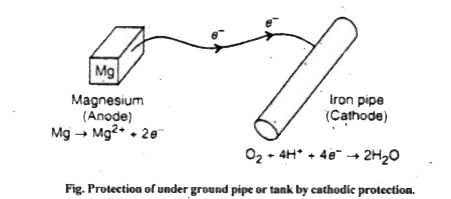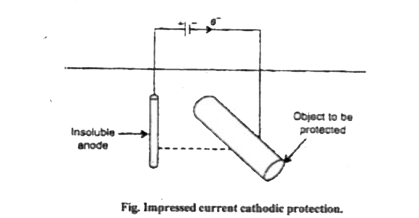(a) What is galvanisation ?
(b) Give three methods to protect iron from rusting.
(c) Discuss the factors responsible for rusting of iron or corrosion.
(d) Name a chemical which is used for preventing rusting of iron.Solution in Punjabi
(a) Galvanisation: Covering of iron surface with a layer of zinc is called galvanisation. It is done by electroplating, or by dipping the iron article in molten zinc or by spraying molten zinc over iron article.
(b) Iron can be protected from rusting by the following methods.
Methods of protecting iron from rusting.
1. Cathodic protection : The principle involved in this method is to force metal to be protected to behave like cathode, thereby preventing corrosion. it can be carried out as follows:
(a) Sacrifical anodic protection method: In this method, the metallic structure to be protected is connected by a wire to a more anodic metal, so that all the corrosion is concentrated at the more active metal. the more active metal itself gets corroded slowly, while the main structure is protected. the more active metal so-employed is called sacrificial anode.
 .
.
This method is used for the protection of submerged structures, ships and undergound pipes. in this method, the exposed surface of iron is protected by connecting it to some more active metal such as magnesium, zinc or aluminium. the more active metal acts as anode and loses electrons in preference to iron. the anode gradually disappears due to the oxidation of the metal to its ions, due to loss of electrons. the iron object gets protected as long as some of the active metal is present.
(b) Impressed current cathodic protection: In this method, current from an external source (like a battery or rectifier on A.C. line) is applied in opposite direction to nullify the corrosion current. in this method, an insoluble or non-attackable anode (like graphite, stainless steel, platinum, high silica iron etc.) is buried in the soil (or immersed in the corroding medium) and connected to the structure to be protected through the source of D.C. current. this method is generally used to protect large structures like open water box coolers, water tanks, buried oiol or water pipes, condensers, transmission line towers, marine piers, laid up ships etc. for long period time.

(c) Sacrificial protection: This method is quite similar to the sacrifical anodic protection method. in this method, the metal to be protected is coated with another more active metal. the more active metal, selected for this purpose should be such that it is protected by a coherent and impervious, self-heating oxide film. for example, iron can be prevented from rusting by covering iron with metals like zinc, magnesium, aluminium etc.
2. Barrier protection : In involves the application of a protective coating on the surface of the metal to be protected. this barrier coating does not allow the corroding environment to come in direct contact with the metal to be protected.
Barrier protection can be achieved by any of the following methods.
(i) By pointing the surface of the metal.
(ii) By coating the metal surface with a thin film of oil or grease.
(iii) By coating metal with some non-corroding metal such as nickel, chromium, aluminium, zinc, tin etc.
When iron is protected by coating with a metal more reactive than iron (say Zn, Al, Mg etc.), then rion. is prevented from rusting even when there are scratches in the coating. on the other hand, if iron is coated with a metal which is less reactive than iron (say Cu, Sn etc.) then rusting of iron is more rapid at places where it is exposed to the atmosphere.
3. Use of corrosion inhibitors : A corrosion inhibitor is a substance which when added in small quantities to the aqueous corrosive environment, effectively reduces the rate of corrosion of themetal. an important corrosion inhibitor is bisphenol.
(c) (i) Air and moisture : These are the two main factors which are responsible for rusting of iron.
(ii) Presence of impurities : Impurities, in general, increase the rate of corrosion.
(iii) Presence of electrolyte in water : Rate of corrosion is more in saline water.
(iv) Strain : Strain in metal increases the rate of corrosion.
(d) Bisphenol.
Topper's Solved these Questions
- ELECTROCHEMISTRYBOOK - BETTER CHOICE PUBLICATIONCHAPTER - ELECTROCHEMISTRYEXERCISE - Numerical Problems
69 Videos
- ELECTROCHEMISTRYBOOK - BETTER CHOICE PUBLICATIONCHAPTER - ELECTROCHEMISTRYEXERCISE - ELECTROLYTIC CELLS AND ELECTROLYSIS
10 Videos
- CO-ORDINATION COMPOUNDSBOOK - BETTER CHOICE PUBLICATIONCHAPTER - CO-ORDINATION COMPOUNDSEXERCISE - QUESTION FROM PREVIOUS BOARD EXAMINATION
59 Videos
- GENERAL PRINCIPLES AND PROCESS OF ISOLATION OF ELEMENTS BOOK - BETTER CHOICE PUBLICATIONCHAPTER - GENERAL PRINCIPLES AND PROCESS OF ISOLATION OF ELEMENTS EXERCISE - Question Bank (6.6 OXIDATION-REDUCTION)
15 Videos
Similar Questions
Derive Nernst equation for the following cell:
NiNi2+(0⋅2M)∣∣∣Cu2+(0⋅2M)∣∣Cu.
View SolutionWhich allotrope of carbon is used in making electrodes ?
View SolutionWrite the IUPAC name of corordination compound [Co(NH3)3ONO]Cl2.
View SolutionName the process from which chlorine is obtained as a bye-product. What will happen if an aqueous solution of NaCl'is:subjected to electrolysis?
View SolutionGalvanisation is a method of protecting iron from rusting by coating it with a thin layer of
View SolutionWrite three methods of preventing rusting of iron .
View SolutionWrite three methods of preventing rusting of iron.
View SolutionGalvanisation is a method of protecting iron from rusting by coating it with a thin layer of ___________
View SolutionWhich of the following method is used to prevent rusting of iron?
View SolutionWrite the chemical equations for all the steps involved in the rusting of iron. Give any one method to prevent rusting of iron.
View SolutionWhat is corrosion? Explain the electro- chemical theory of rusting of iron and write the reactions involved in the rusting of iron?
View SolutionRusting in iron is an unwanted oxidation In what ways can iron rust be prevented?
View SolutionChemical Changes: Rusting Of Iron|Galvanisation#!#Crystallization
View SolutionGalvanisation is a method of protecting iron from rusting by coating it with a thin layer of
View SolutionGalvanisation is a method of protecting iron from rusting by coating it with a thin layer of
View SolutionGalvanisation is a method of protecting iron from rusting by coating it with a thin layer of ______
View Solution
